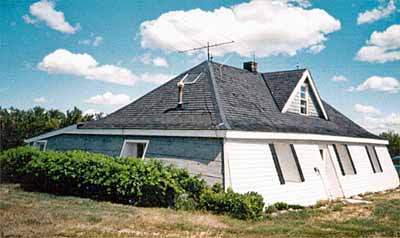Addison Sod House National Historic Site of Canada
Kindersley, Saskatchewan

General view
(© Parks Canada | Parcs Canada)
Address :
Highway 21, Rural Municipality of Oakdale no. 320, Kindersley, Saskatchewan
Recognition Statute:
Historic Sites and Monuments Act (R.S.C., 1985, c. H-4)
Designation Date:
2004-03-05
Dates:
-
1909 to 1911
(Construction)
Event, Person, Organization:
Other Name(s):
-
Addison Sod House
(Designation Name)
Research Report Number:
2003-004
Plaque(s)
Existing plaque: Highway 21, Kindersley, Saskatchewan
Built by English carpenter James Addison between 1909 and 1911, this modest farmhouse is a remarkably well-preserved example of sod construction. Thousands of settlers in the grasslands of the Canadian West built their first homes out of sod bricks. Intended simply to get the homesteaders through their first difficult years on the land, virtually all of these "soddies" have since disappeared. The Addison house, originally covered in vines for weatherproofing and now protected by exterior cladding, survives as a rare illustration of an important prairie settlement phenomenon.
Description of Historic Place
The Addison Sod House National Historic Site of Canada is located in the rural municipality of Oakdale, Saskatchewan. Set in an open, flat, prairie environment the low one-and-a-half storey massing, inward sloping exterior walls and the angle of the low, hipped roof combine to give this small house a distinctive, almost pyramidal appearance. Triangular-shaped dormers light the upper floor. Set back from the road the house forms the centre of an original prairie homestead amongst outbuildings surrounded by a garden and shelterbelt plantings. Official recognition refers to the sod house on its footprint.
Heritage Value
Addison Sod House was designated a national historic site of Canada because: it is a remarkably well-preserved and rare surviving example of the sod type of construction, an important prairie settlement phenomenon, which was used extensively in the tall-grass regions of the Canadian West.
Carpenter Jim Addison built Addison Sod House in 1909-1911 as the residence for his family on his homestead. The care with which the sods were prepared and constructed ensured that this house survived for much longer than many others of its kind. On recognizing its durability, the owner further developed the home, enhancing its interior layout and finishes as well as adding a lean-to. The house is set within a grouping of outbuildings, gardens and shelterbelt plantings typical of a prairie farmstead from the early 20th century.
The heritage value of Addison Sod House resides in the integrity with which this house represents a prairie “soddy”, specifically its form, construction techniques, sod brick building materials, and setting.
Source: Historic Sites and Monuments Board of Canada, Minutes, July 2003.
Character-Defining Elements
Key features contributing to the heritage value of this site include: its location in the rural municipality of Oakdale, Saskatchewan; its setting in the open prairie on a homestead surrounded by a garden and protected by a shelterbelt; its rectangular footprint, and its low one-and-a-half-storey, pyramidal massing set under a hipped roof with centrally placed triangular dormers on both front and rear; its long rear single-storey addition under a shed roof; its three-bay façade with regularly spaced deep set windows and door; its building materials including its sod brick construction technology with tapered walls; the skilfully crafted wood framing of the wood-shingled hip roof; its successive layers of protective cladding including wood, asphalt and vinyl; the domestic interior layout, including its earthen cellar; its successive layers of interior finishing materials, including plaster and wallpaper.